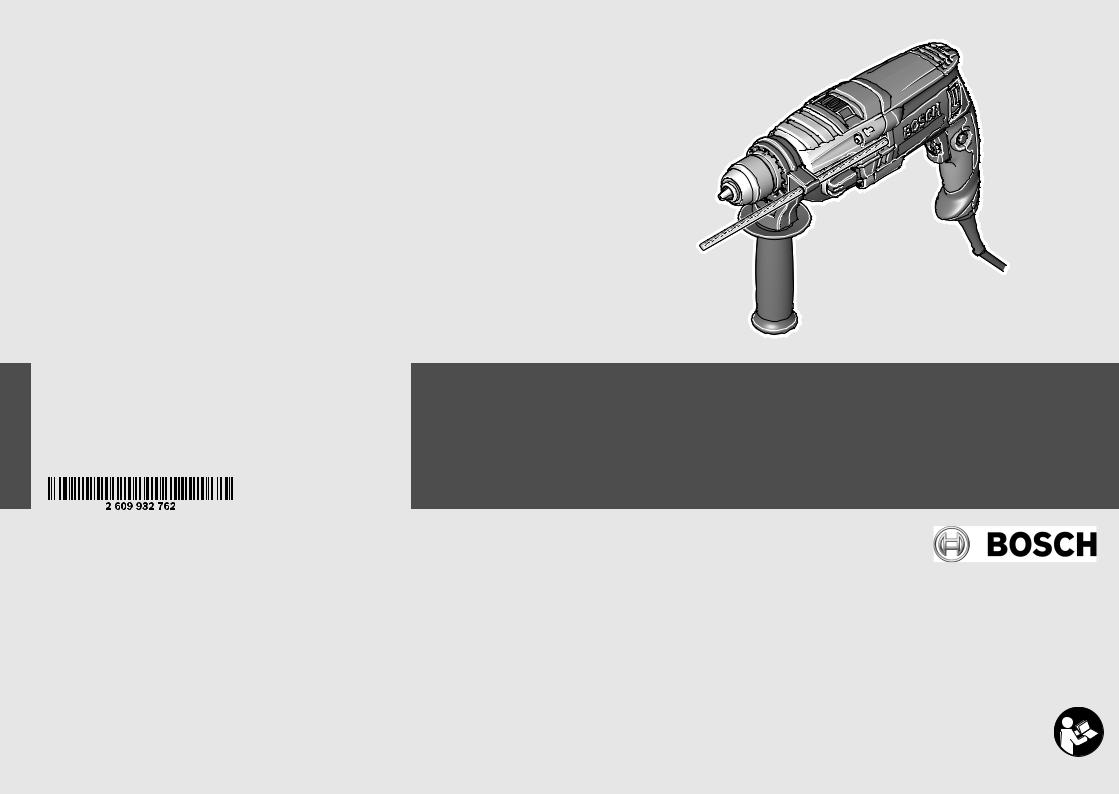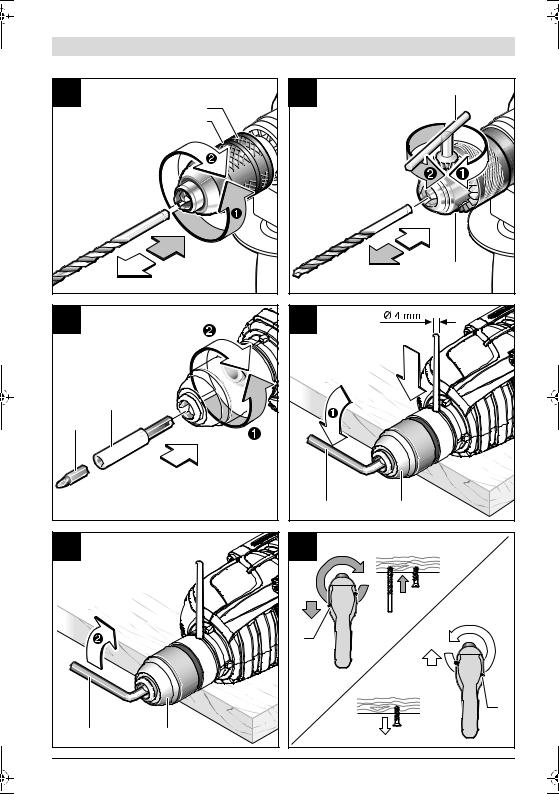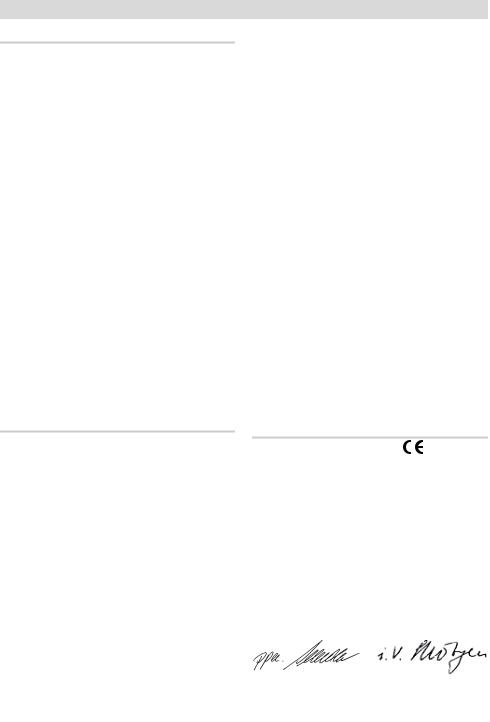Bosch GSB 19-2 RE Professional, GSB 780 Professional User guide [ml]

Robert Bosch GmbH
Power Tools Division
70745 Leinfelden-Echterdingen
Germany
www.bosch-pt.com
2 609 932 762 (2010.03) O / 140 WEU
GSB Professional
19-2 RE | 780
|
|
|
|
de |
Originalbetriebsanleitung |
el |
Πρωτότυπο οδηγιών χρήσης |
en |
Original instructions |
tr |
Orijinal işletme talimat |
fr |
Notice originale |
ar |
ΔϴϠλϷ ϞϴϐθΘϟ ΕΎϤϴϠόΗ |
es |
Manual original |
fa |
̶Ϡλ έΎ̯ ίήσ ̵ΎϤϨϫέ |
pt |
Manual original |
|
|
it |
Istruzioni originali |
|
|
nl |
Oorspronkelijke |
|
|
|
gebruiksaanwijzing |
|
|
da Original brugsanvisning |
|
|
|
sv |
Bruksanvisning i original |
|
|
no |
Original driftsinstruks |
|
|
fi |
Alkuperäiset ohjeet |
|
|

2 |
Deutsch . . . . . . . . . . . . . . . . . . . . . . . . . . . |
. Seite |
6 |
English . . . . . . . . . . . . . . . . . . . . . . . . . . . . |
. Page |
16 |
Français . . . . . . . . . . . . . . . . . . . . . . . . . . . |
. Page |
25 |
Español. . . . . . . . . . . . . . . . . . . . . . . . . . . . |
Página |
35 |
Português . . . . . . . . . . . . . . . . . . . . . . . . . . |
Página |
45 |
Italiano . . . . . . . . . . . . . . . . . . . . . . . . . . . . |
Pagina |
54 |
Nederlands . . . . . . . . . . . . . . . . . . . . . . . . . |
Pagina |
63 |
Dansk . . . . . . . . . . . . . . . . . . . . . . . . . . . . . |
. Side |
72 |
Svenska . . . . . . . . . . . . . . . . . . . . . . . . . . . |
. Sida |
81 |
Norsk . . . . . . . . . . . . . . . . . . . . . . . . . . . . . |
. Side |
89 |
Suomi . . . . . . . . . . . . . . . . . . . . . . . . . . . . . |
. .Sivu |
97 |
Ελληνικά . . . . . . . . . . . . . . . . . . . . . . . . . . . |
Σελίδα |
105 |
Türkçe . . . . . . . . . . . . . . . . . . . . . . . . . . . . |
. Sayfa |
114 |
. . . . . . . . . . . . . . . . . . . . . . . . . . . . . . . . . . . |
. ΔΤϔλ |
130 |
vÝ—U . . . . . . . . . . . . . . . . . . . . . . . . . . . . . . . . . . . |
ϪΤϔλ |
139 |
2 609 932 762 | (2.3.10) |
Bosch Power Tools |

3 |
2 608 180 009 (DP 500)
2 608 030 053 (MS 65)
2 608 030 055 (MS 80)
2 602 025 190
1 613 001 010
GSB 19-2 RE:
2 608 572 149
GSB 780:
2 608 572 105
GSB 19-2 RE:
2 608 571 067
2 607 990 050 (S 41)
2 605 438 524
2 609 932 762 | (2.3.10) |
Bosch Power Tools |

4 |
|
2 |
1 |
3 |
|
|
|
4 |
|
5 |
|
6 |
|
7 |
9 |
|
|
8 |
|
10 |
GSB 19-2 RE |
8 |
Professional |
|
A |
B |
|
1 |
9 |
8 |
2 609 932 762 | (2.3.10) |
Bosch Power Tools |

5 | |
|
|
C |
D |
13 |
|
||
|
12 |
|
|
11 |
|
|
|
14 |
E |
F |
|
16 |
|
|
15 |
|
|
|
17 |
1 |
G |
H |
|
|
3 |
|
|
|
3 |
17 |
1 |
|
2 609 932 762 | (2.3.10) |
|
Bosch Power Tools |

6 | Deutsch
Sicherheitshinweise
Allgemeine Sicherheitshinweise für Elektrowerkzeuge
|
Lesen Sie alle Sicherheitshin- |
WARNUNG |
|
|
weise und Anweisungen. Ver- |
säumnisse bei der Einhaltung der Sicherheitshinweise und Anweisungen können elektrischen Schlag, Brand und/oder schwere Verletzungen verursachen.
Bewahren Sie alle Sicherheitshinweise und Anweisungen für die Zukunft auf.
Der in den Sicherheitshinweisen verwendete Begriff „Elektrowerkzeug“ bezieht sich auf netzbetriebene Elektrowerkzeuge (mit Netzkabel) und auf akkubetriebene Elektrowerkzeuge (ohne Netzkabel).
1)Arbeitsplatzsicherheit
a)Halten Sie Ihren Arbeitsbereich sauber und gut beleuchtet. Unordnung oder unbeleuchtete Arbeitsbereiche können zu Unfällen führen.
b)Arbeiten Sie mit dem Elektrowerkzeug nicht in explosionsgefährdeter Umgebung, in der sich brennbare Flüssigkeiten, Gase oder Stäube befinden. Elektrowerkzeuge erzeugen Funken, die den Staub oder die Dämpfe entzünden können.
c)Halten Sie Kinder und andere Personen während der Benutzung des Elektrowerkzeugs fern. Bei Ablenkung können Sie die Kontrolle über das Gerät verlieren.
2)Elektrische Sicherheit
a)Der Anschlussstecker des Elektrowerkzeuges muss in die Steckdose passen. Der Stecker darf in keiner Weise verändert werden. Verwenden Sie keine Adapterstecker gemeinsam mit schutzgeerdeten Elektrowerkzeugen. Unveränderte Stecker und passende Steckdosen verringern das Risiko eines elektrischen Schlages.
b)Vermeiden Sie Körperkontakt mit geerdeten Oberflächen wie von Rohren, Heizungen, Herden und Kühlschränken. Es besteht ein erhöhtes Risiko durch elektrischen Schlag, wenn Ihr Körper geerdet ist.
c)Halten Sie Elektrowerkzeuge von Regen oder Nässe fern. Das Eindringen von Wasser in ein Elektrowerkzeug erhöht das Risiko eines elektrischen Schlages.
d)Zweckentfremden Sie das Kabel nicht, um das Elektrowerkzeug zu tragen, aufzuhängen oder um den Stecker aus der Steckdose zu ziehen. Halten Sie das Kabel fern von Hitze, Öl, scharfen Kanten oder sich bewegenden Geräteteilen. Beschädigte oder verwickelte Kabel erhöhen das Risiko eines elektrischen Schlages.
e)Wenn Sie mit einem Elektrowerkzeug im Freien arbeiten, verwenden Sie nur Verlängerungskabel, die auch für den Außenbereich geeignet sind. Die Anwendung eines für den Außenbereich geeigneten Verlängerungskabels verringert das Risiko eines elektrischen Schlages.
f)Wenn der Betrieb des Elektrowerkzeuges in feuchter Umgebung nicht vermeidbar ist, verwenden Sie einen Fehlerstromschutzschalter. Der Einsatz eines Fehlerstromschutzschalters vermindert das Risiko eines elektrischen Schlages.
3)Sicherheit von Personen
a)Seien Sie aufmerksam, achten Sie darauf, was Sie tun, und gehen Sie mit Vernunft an die Arbeit mit einem Elektrowerkzeug. Benutzen Sie kein Elektrowerkzeug, wenn Sie müde sind oder unter dem Einfluss von Drogen, Alkohol oder Medikamenten stehen. Ein Moment der Unachtsamkeit beim Gebrauch des Elektrowerkzeuges kann zu ernsthaften Verletzungen führen.
2 609 932 762 | (2.3.10) |
Bosch Power Tools |

b)Tragen Sie persönliche Schutzausrüstung und immer eine Schutzbrille. Das Tragen persönlicher Schutzausrüstung, wie Staubmaske, rutschfeste Sicherheitsschuhe, Schutzhelm oder Gehörschutz, je nach Art und Einsatz des Elektrowerkzeuges, verringert das Risiko von Verletzungen.
c)Vermeiden Sie eine unbeabsichtigte Inbetriebnahme. Vergewissern Sie sich, dass das Elektrowerkzeug ausgeschaltet ist, bevor Sie es an die Stromversorgung und/oder den Akku anschließen, es aufnehmen oder tragen. Wenn Sie beim Tragen des Elektrowerkzeuges den Finger am Schalter haben oder das Gerät eingeschaltet an die Stromversorgung anschließen, kann dies zu Unfällen führen.
d)Entfernen Sie Einstellwerkzeuge oder Schraubenschlüssel, bevor Sie das Elektrowerkzeug einschalten. Ein Werkzeug oder Schlüssel, der sich in einem drehenden Geräteteil befindet, kann zu Verletzungen führen.
e)Vermeiden Sie eine abnormale Körperhaltung. Sorgen Sie für einen sicheren Stand und halten Sie jederzeit das Gleichgewicht. Dadurch können Sie das Elektrowerkzeug in unerwarteten Situationen besser kontrollieren.
f)Tragen Sie geeignete Kleidung. Tragen Sie keine weite Kleidung oder Schmuck. Halten Sie Haare, Kleidung und Handschuhe fern von sich bewegenden Teilen. Lockere Kleidung, Schmuck oder lange Haare können von sich bewegenden Teilen erfasst werden.
g)Wenn Staubabsaugund -auffangein- richtungen montiert werden können, vergewissern Sie sich, dass diese angeschlossen sind und richtig verwendet werden. Verwendung einer Staubabsaugung kann Gefährdungen durch Staub verringern.
Deutsch | 7
4)Verwendung und Behandlung des Elektrowerkzeuges
a)Überlasten Sie das Gerät nicht. Verwenden Sie für Ihre Arbeit das dafür bestimmte Elektrowerkzeug. Mit dem passenden Elektrowerkzeug arbeiten Sie besser und sicherer im angegebenen Leistungsbereich.
b)Benutzen Sie kein Elektrowerkzeug, dessen Schalter defekt ist. Ein Elektrowerkzeug, das sich nicht mehr einoder ausschalten lässt, ist gefährlich und muss repariert werden.
c)Ziehen Sie den Stecker aus der Steckdose und/oder entfernen Sie den Akku, bevor Sie Geräteeinstellungen vornehmen, Zubehörteile wechseln oder das Gerät weglegen. Diese Vorsichtsmaßnahme verhindert den unbeabsichtigten Start des Elektrowerkzeuges.
d)Bewahren Sie unbenutzte Elektrowerkzeuge außerhalb der Reichweite von Kindern auf. Lassen Sie Personen das Gerät nicht benutzen, die mit diesem nicht vertraut sind oder diese Anweisungen nicht gelesen haben. Elektrowerkzeuge sind gefährlich, wenn sie von unerfahrenen Personen benutzt werden.
e)Pflegen Sie Elektrowerkzeuge mit Sorgfalt. Kontrollieren Sie, ob bewegliche Teile einwandfrei funktionieren und nicht klemmen, ob Teile gebrochen oder so beschädigt sind, dass die Funktion des Elektrowerkzeuges beeinträchtigt ist. Lassen Sie beschädigte Teile vor dem Einsatz des Gerätes reparieren. Viele Unfälle haben ihre Ursache in schlecht gewarteten Elektrowerkzeugen.
f)Halten Sie Schneidwerkzeuge scharf und sauber. Sorgfältig gepflegte Schneidwerkzeuge mit scharfen Schneidkanten verklemmen sich weniger und sind leichter zu führen.
Bosch Power Tools |
2 609 932 762 | (2.3.10) |

8 | Deutsch
g)Verwenden Sie Elektrowerkzeug, Zubehör, Einsatzwerkzeuge usw. entsprechend diesen Anweisungen. Berücksichtigen Sie dabei die Arbeitsbedingungen und die auszuführende Tätigkeit. Der Gebrauch von Elektrowerkzeugen für andere als die vorgesehenen Anwendungen kann zu gefährlichen Situationen führen.
5)Service
a)Lassen Sie Ihr Elektrowerkzeug nur von qualifiziertem Fachpersonal und nur mit Original-Ersatzteilen reparieren. Damit wird sichergestellt, dass die Sicherheit des Elektrowerkzeuges erhalten bleibt.
Sicherheitshinweise für Bohrmaschinen
fTragen Sie Gehörschutz beim Schlagbohren. Die Einwirkung von Lärm kann Gehörverlust bewirken.
fBenutzen Sie mit dem Gerät gelieferte Zusatzhandgriffe. Der Verlust der Kontrolle kann zu Verletzungen führen.
fHalten Sie das Gerät an den isolierten Griffflächen, wenn Sie Arbeiten ausführen, bei denen das Einsatzwerkzeug verborgene Stromleitungen oder das eigene Netzkabel treffen kann. Der Kontakt mit einer spannungsführenden Leitung kann auch metallene Geräteteile unter Spannung setzen und zu einem elektrischen Schlag führen.
fVerwenden Sie geeignete Suchgeräte, um verborgene Versorgungsleitungen aufzuspüren, oder ziehen Sie die örtliche Versorgungsgesellschaft hinzu. Kontakt mit Elektroleitungen kann zu Feuer und elektrischem Schlag führen. Beschädigung einer Gasleitung kann zur Explosion führen. Eindringen in eine Wasserleitung verursacht Sachbeschädigung.
fHalten Sie das Elektrowerkzeug beim Arbeiten fest mit beiden Händen und sorgen Sie für einen sicheren Stand. Das Elektrowerkzeug wird mit zwei Händen sicherer geführt.
fSichern Sie das Werkstück. Ein mit Spannvorrichtungen oder Schraubstock festgehaltenes Werkstück ist sicherer gehalten als mit Ihrer Hand.
fHalten Sie Ihren Arbeitsplatz sauber. Materialmischungen sind besonders gefährlich. Leichtmetallstaub kann brennen oder explodieren.
fWarten Sie, bis das Elektrowerkzeug zum Stillstand gekommen ist, bevor Sie es ablegen. Das Einsatzwerkzeug kann sich verhaken und zum Verlust der Kontrolle über das Elektrowerkzeug führen.
fBenutzen Sie das Elektrowerkzeug nicht mit beschädigtem Kabel. Berühren Sie das beschädigte Kabel nicht und ziehen Sie den Netzstecker, wenn das Kabel während des Arbeitens beschädigt wird. Beschädigte Kabel erhöhen das Risiko eines elektrischen Schlages.
Funktionsbeschreibung
Lesen Sie alle Sicherheitshinweise und Anweisungen. Versäumnisse
bei der Einhaltung der Sicherheits-
hinweise und Anweisungen können elektrischen Schlag, Brand
und/oder schwere Verletzungen verursachen.
Bitte klappen Sie die Aufklappseite mit der Darstellung des Elektrowerkzeugs auf, und lassen Sie diese Seite aufgeklappt, während Sie die Betriebsanleitung lesen.
Bestimmungsgemäßer Gebrauch
Das Elektrowerkzeug ist bestimmt zum Schlagbohren in Ziegel, Beton und Gestein, sowie zum Bohren in Holz, Metall, Keramik und Kunststoff. Geräte mit elektronischer Regelung und Rechts-/Linkslauf sind auch geeignet zum Schrauben und Gewindeschneiden.
2 609 932 762 | (2.3.10) |
Bosch Power Tools |

Abgebildete Komponenten
Die Nummerierung der abgebildeten Komponenten bezieht sich auf die Darstellung des Elektrowerkzeuges auf der Grafikseite.
1Schnellspannbohrfutter
2Umschalter „Bohren/Schlagbohren“
3Drehrichtungsumschalter
4Feststelltaste für Ein-/Ausschalter
5Stellrad Drehzahlvorwahl
6Ein-/Ausschalter
7Gangwahlschalter
8Zusatzgriff (isolierte Grifffläche)*
9Tiefenanschlag*
10Handgriff (isolierte Grifffläche)
11Vordere Hülse*
12Hintere Hülse*
13Bohrfutterschlüssel*
14Zahnkranzbohrfutter*
15Schrauberbit*
16Universalbithalter*
17Innensechskantschlüssel *
*Abgebildetes oder beschriebenes Zubehör gehört nicht zum Standard-Lieferumfang. Das vollständige Zubehör finden Sie in unserem Zubehörprogramm.
Deutsch | 9
Der in diesen Anweisungen angegebene Schwingungspegel ist entsprechend einem in EN 60745 genormten Messverfahren gemessen worden und kann für den Vergleich von Elektrowerkzeugen miteinander verwendet werden. Er eignet sich auch für eine vorläufige Einschätzung der Schwingungsbelastung.
Der angegebene Schwingungspegel repräsentiert die hauptsächlichen Anwendungen des Elektrowerkzeugs. Wenn allerdings das Elektrowerkzeug für andere Anwendungen, mit abweichenden Einsatzwerkzeugen oder ungenügender Wartung eingesetzt wird, kann der Schwingungspegel abweichen. Dies kann die Schwingungsbelastung über den gesamten Arbeitszeitraum deutlich erhöhen.
Für eine genaue Abschätzung der Schwingungsbelastung sollten auch die Zeiten berücksichtigt werden, in denen das Gerät abgeschaltet ist oder zwar läuft, aber nicht tatsächlich im Einsatz ist. Dies kann die Schwingungsbelastung über den gesamten Arbeitszeitraum deutlich reduzieren.
Legen Sie zusätzliche Sicherheitsmaßnahmen zum Schutz des Bedieners vor der Wirkung von Schwingungen fest wie zum Beispiel: Wartung von Elektrowerkzeug und Einsatzwerkzeugen, Warmhalten der Hände, Organisation der Arbeitsabläufe.
Geräusch-/Vibrationsinformation
Messwerte für Geräusch ermittelt entsprechend EN 60745.
Der A-bewertete Geräuschpegel des Elektrowerkzeugs beträgt typischerweise: Schalldruckpegel 95 dB(A); Schallleistungspegel
106 dB(A). Unsicherheit K=3 dB.
Gehörschutz tragen!
Schwingungsgesamtwerte (Vektorsumme dreier Richtungen) ermittelt entsprechend EN 60745: Bohren in Metall: Schwingungsemissionswert ah =3,0 m/s2, Unsicherheit K =1,5 m/s2, Schlagbohren in Beton: Schwingungsemissionswert ah =15 m/s2, Unsicherheit K =2,0 m/s2, Schrauben: Schwingungsemissionswert
ah <2,5 m/s2, Unsicherheit K=1,5 m/s2, Gewindeschneiden: Schwingungsemissionswert ah<2,5 m/s2, Unsicherheit K=1,5 m/s2.
Konformitätserklärung
Wir erklären in alleiniger Verantwortung, dass das unter „Technische Daten“ beschriebene Produkt mit den folgenden Normen oder normativen Dokumenten übereinstimmt: EN 60745 gemäß den Bestimmungen der Richtlinien 2004/108/EG, 2006/42/EG.
Technische Unterlagen bei: Robert Bosch GmbH, PT/ESC, D-70745 Leinfelden-Echterdingen
Dr. Egbert Schneider |
Dr. Eckerhard Strötgen |
Senior Vice President |
Head of Product |
Engineering |
Certification |
Robert Bosch GmbH, Power Tools Division D-70745 Leinfelden-Echterdingen 18.02.2010
Bosch Power Tools |
2 609 932 762 | (2.3.10) |

10 | Deutsch
Technische Daten
Schlagbohrmaschine |
|
GSB 19-2 RE |
GSB 19-2 RE |
GSB 780 |
|
|
Professional |
Professional |
Professional |
Sachnummer |
|
3 601 A7B 5.. |
3 601 A7B 6.. |
3 601 A7B 1.. |
Nennaufnahmeleistung |
W |
850 |
850 |
780 |
Abgabeleistung |
W |
430 |
430 |
390 |
Leerlaufdrehzahl |
min-1 |
|
|
|
– 1. Gang |
0 – 1000 |
0 – 1000 |
0 – 1000 |
|
– 2. Gang |
min-1 |
0 – 3000 |
0 – 3000 |
0 – 3000 |
Nenndrehzahl |
min-1 |
|
|
|
– 1. Gang |
800 |
800 |
850 |
|
– 2. Gang |
min-1 |
2060 |
2060 |
2170 |
Schlagzahl bei Leerlaufdrehzahl |
min-1 |
51000 |
51000 |
51000 |
Nenndrehmoment (1./2. Gang) |
Nm |
5,2/2,0 |
5,2/2,0 |
4,1/1,6 |
Drehzahlvorwahl |
|
z |
z |
z |
Rechts-/Linkslauf |
|
z |
z |
z |
Zahnkranzbohrfutter |
|
– |
z |
– |
Schnellspannbohrfutter |
|
z |
– |
z |
Vollautomatische Spindelarretierung |
|
|
|
|
(Auto-Lock) |
|
z |
– |
– |
Spindelhalsdurchmesser |
mm |
43 |
43 |
43 |
max. Bohr-Ø (1./2. Gang) |
|
|
|
|
– Beton |
mm |
18/13 |
18/13 |
18/13 |
– Mauerwerk |
mm |
20/15 |
20/15 |
20/15 |
– Stahl |
mm |
13/8 |
13/8 |
13/8 |
– Holz |
mm |
40/25 |
40/25 |
40/25 |
Bohrfutterspannbereich |
mm |
1,5 – 13 |
1,5 – 13 |
1,5 – 13 |
Gewicht entsprechend EPTA-Procedure |
|
|
|
|
01/2003 |
kg |
2,6 |
2,6 |
2,6 |
Schutzklasse |
|
/II |
/II |
/II |
|
|
|
|
|
Angaben gelten für Nennspannungen [U] 230/240 V. Bei niedrigeren Spannungen und in länderspezifischen Ausführungen können diese Angaben variieren.
Bitte beachten Sie die Sachnummer auf dem Typenschild Ihres Elektrowerkzeugs. Die Handelsbezeichnungen einzelner Elektrowerkzeuge können variieren.
2 609 932 762 | (2.3.10) |
Bosch Power Tools |

Montage
fZiehen Sie vor allen Arbeiten am Elektrowerkzeug den Netzstecker aus der Steckdose.
Zusatzgriff (siehe Bild A)
fVerwenden Sie Ihr Elektrowerkzeug nur mit dem Zusatzgriff 8.
Sie können den Zusatzgriff 8 in 12 Positionen verstellen, um eine sichere und ermüdungsarme Arbeitshaltung zu erreichen.
Drehen Sie das untere Griffstück des Zusatzgriffs 8 in Drehrichtung n und schieben Sie den Zusatzgriff 8 soweit nach vorn, bis Sie ihn in die gewünschte Position schwenken können. Danach ziehen Sie den Zusatzgriff 8 wieder zurück und drehen das untere Griffstück in Drehrichtung o wieder fest.
Bohrtiefe einstellen (siehe Bild A)
Mit dem Tiefenanschlag 9 kann die gewünschte Bohrtiefe X festgelegt werden.
Drehen Sie das untere Griffstück des Zusatzgriffs 8 entgegen dem Uhrzeigersinn und setzen Sie den Tiefenanschlag 9 ein.
Ziehen Sie den Tiefenanschlag so weit heraus, dass der Abstand zwischen der Spitze des Bohrers und der Spitze des Tiefenanschlags der gewünschten Bohrtiefe X entspricht.
Drehen Sie danach das untere Griffstück des Zusatzgriffs 8 im Uhrzeigersinn wieder fest.
Die Riffelung am Tiefenanschlag 9 muss nach oben zeigen.
Werkzeugwechsel
fTragen Sie beim Werkzeugwechsel Schutzhandschuhe. Das Bohrfutter kann sich bei längeren Arbeitsvorgängen stark erwärmen.
Schnellspannbohrfutter (GSB 19-2 RE) (siehe Bild B)
Bei nicht gedrücktem Ein-/Ausschalter 6 wird die Bohrspindel arretiert. Dies ermöglicht ein schnelles, bequemes und einfaches Wechseln des Einsatzwerkzeuges im Bohrfutter.
Deutsch | 11
Öffnen Sie das Schnellspannbohrfutter 1 durch Drehen in Drehrichtung n, bis das Werkzeug eingesetzt werden kann. Setzen Sie das Werkzeug ein.
Drehen Sie die Hülse des Schnellspannbohrfutters 1 in Drehrichtung o von Hand kräftig zu, bis kein Überrasten mehr hörbar ist. Das Bohrfutter wird dadurch automatisch verriegelt.
Die Verriegelung löst sich wieder, wenn Sie zum Entfernen des Werkzeuges die Hülse in Gegenrichtung drehen.
Schnellspannbohrfutter (GSB 780) (siehe Bild C)
Halten Sie die hintere Hülse 12 des Schnellspannbohrfutters 1 fest und drehen Sie die vordere Hülse 11 in Drehrichtung n, bis das Werkzeug eingesetzt werden kann. Setzen Sie das Werkzeug ein.
Halten Sie die hintere Hülse 12 des Schnellspannbohrfutters 1 fest und drehen Sie die vordere Hülse 11 in Drehrichtung o von Hand kräftig zu, bis kein Überrasten mehr hörbar ist. Das Bohrfutter wird dadurch automatisch verriegelt.
Die Verriegelung löst sich wieder, wenn Sie zum Entfernen des Werkzeuges die vordere Hülse 11 in Gegenrichtung drehen.
Zahnkranzbohrfutter (siehe Bild D)
Öffnen Sie das Zahnkranzbohrfutter 14 durch Drehen, bis das Werkzeug eingesetzt werden kann. Setzen Sie das Werkzeug ein.
Stecken Sie den Bohrfutterschlüssel 13 in die entsprechenden Bohrungen des Zahnkranzbohrfutters 14 und spannen Sie das Werkzeug gleichmäßig fest.
Schraubwerkzeuge (siehe Bild E)
Bei der Verwendung von Schrauberbits 15 sollten Sie immer einen Universalbithalter 16 benutzen. Verwenden Sie nur zum Schraubenkopf passende Schrauberbits.
Zum Schrauben stellen Sie den Umschalter „Bohren/Schlagbohren“ 2 immer auf das Symbol „Bohren“.
Bosch Power Tools |
2 609 932 762 | (2.3.10) |

12 | Deutsch
Bohrfutter wechseln
fZiehen Sie vor allen Arbeiten am Elektrowerkzeug den Netzstecker aus der Steckdose.
Bohrfutter demontieren (siehe Bild F)
Demontieren Sie den Zusatzgriff und bringen Sie den Gangwahlschalter 7 in die Mittelstellung zwischen 1. und 2. Gang.
Führen Sie einen Stahlstift Ø 4 mm mit ca. 50 mm Länge in die Bohrung am Spindelhals ein, um die Bohrspindel zu arretieren.
Spannen Sie einen Innensechskantschlüssel 17 mit dem kurzen Schaft voran in das Schnellspannbohrfutter 1 ein.
Legen Sie das Elektrowerkzeug auf eine standfeste Unterlage, z. B. eine Werkbank. Halten Sie das Elektrowerkzeug fest und lösen Sie das Schnellspannbohrfutter 1 durch Drehen des Innensechskantschlüssels 17 in Drehrichtung n. Ein festsitzendes Schnellspannbohrfutter wird durch einen leichten Schlag auf den langen Schaft des Innensechskantschlüssels 17 gelöst. Entfernen Sie den Innensechskantschlüssel aus dem Schnellspannbohrfutter und schrauben Sie das Schnellspannbohrfutter vollständig ab.
Bei Elektrowerkzeugen mit Zahnkranzbohrfutter erfolgt die Demontage sinngemäß wie oben beschrieben.
Bei Elektrowerkzeugen mit Schnellspannbohrfutter kann anstatt des Innensechskantschlüssels ein Gabelschlüssel (Schlüsselweite 19 mm) auf das Bohrfutter aufgesetzt werden.
Bohrfutter montieren (siehe Bild G)
Die Montage des Schnellspann-/Zahnkranzbohr- futters erfolgt in umgekehrter Reihenfolge.
fEntfernen Sie nach erfolgter Montage des Bohrfutters den Stahlstift wieder aus der Bohrung.
Das Bohrfutter muss mit einem Anzugsdrehmoment von ca. 50–55 Nm festgezogen werden.
Staub-/Späneabsaugung
fStäube von Materialien wie bleihaltigem Anstrich, einigen Holzarten, Mineralien und Metall können gesundheitsschädlich sein. Berühren oder Einatmen der Stäube können allergische Reaktionen und/oder Atemwegserkrankungen des Benutzers oder in der Nähe befindlicher Personen hervorrufen. Bestimmte Stäube wie Eichenoder Buchenstaub gelten als krebserzeugend, besonders in Verbindung mit Zusatzstoffen zur Holzbehandlung (Chromat, Holzschutzmittel). Asbesthaltiges Material darf nur von Fachleuten bearbeitet werden.
–Sorgen Sie für gute Belüftung des Arbeitsplatzes.
–Es wird empfohlen, eine Atemschutzmaske mit Filterklasse P2 zu tragen.
Beachten Sie in Ihrem Land gültige Vorschriften für die zu bearbeitenden Materialien.
Betrieb
Inbetriebnahme
fBeachten Sie die Netzspannung! Die Spannung der Stromquelle muss mit den Angaben auf dem Typenschild des Elektrowerkzeuges übereinstimmen. Mit 230 V gekennzeichnete Elektrowerkzeuge können auch an 220 V betrieben werden.
Drehrichtung einstellen (siehe Bild H)
fBetätigen Sie den Drehrichtungsumschalter 3 nur bei Stillstand des Elektrowerkzeuges.
Mit dem Drehrichtungsumschalter 3 können Sie die Drehrichtung des Elektrowerkzeuges ändern. Bei gedrücktem Ein-/Ausschalter 6 ist dies jedoch nicht möglich.
Rechtslauf: Zum Bohren und Eindrehen von Schrauben schieben Sie den Drehrichtungsumschalter 3 auf der linken Seite nach unten und gleichzeitig auf der rechten Seite nach oben.
2 609 932 762 | (2.3.10) |
Bosch Power Tools |

Linkslauf: Zum Lösen bzw. Herausdrehen von Schrauben und Muttern schieben Sie den Drehrichtungsumschalter 3 auf der linken Seite nach oben und gleichzeitig auf der rechten Seite nach unten.
Betriebsart einstellen
Bohren und Schrauben
Stellen Sie den Umschalter 2 auf das Symbol „Bohren“.
Schlagbohren
Stellen Sie den Umschalter 2 auf das Symbol „Schlagbohren“.
Der Umschalter 2 rastet spürbar ein und kann auch bei laufendem Motor betätigt werden.
Mechanische Gangwahl
fSie können den Gangwahlschalter 7 bei langsam laufendem Elektrowerkzeug betätigen. Dies sollte jedoch nicht bei Stillstand, voller Belastung oder maximaler Drehzahl erfolgen.
Mit dem Gangwahlschalter 7 können 2 Drehzahlbereiche vorgewählt werden.
Gang I:
Niedriger Drehzahlbereich; zum Arbeiten mit großem Bohrdurchmes-
ser oder zum Schrauben.
Gang II:
Hoher Drehzahlbereich; zum Arbeiten mit kleinem Bohrdurchmesser.
Lässt sich der Gangwahlschalter 7 nicht bis zum Anschlag schwenken, drehen Sie die Antriebsspindel mit dem Bohrer etwas.
Ein-/Ausschalten
Drücken Sie zur Inbetriebnahme des Elektrowerkzeuges den Ein-/Ausschalter 6 und halten Sie ihn gedrückt.
Zum Feststellen des gedrückten Ein-/Ausschal- ters 6 drücken Sie die Feststelltaste 4.
Um das Elektrowerkzeug auszuschalten lassen Sie den Ein-/Ausschalter 6 los bzw. wenn er mit der Feststelltaste 4 arretiert ist, drücken Sie den Ein-/Ausschalter 6 kurz und lassen ihn dann los.
Deutsch | 13
Überlastkupplung
Um gefährliche Reaktionsmomente zu begrenzen, ist das Elektrowerkzeug mit einer Überlastkupplung (Anti-Rotation) ausgestattet.
fKlemmt oder hakt das Einsatzwerkzeug, wird der Antrieb zur Bohrspindel unterbrochen. Halten Sie, wegen der dabei auftretenden Kräfte, das Elektrowerkzeug immer mit beiden Händen gut fest und nehmen Sie einen festen Stand ein.
fSchalten Sie das Elektrowerkzeug aus und lösen Sie das Einsatzwerkzeug, wenn das Elektrowerkzeug blockiert. Beim Einschalten mit einem blockierten Bohrwerkzeug entstehen hohe Reaktionsmomente.
Drehzahl/Schlagzahl einstellen
Sie können die Drehzahl/Schlagzahl des eingeschalteten Elektrowerkzeugs stufenlos regulieren, je nachdem, wie weit Sie den Ein-/Ausschal- ter 6 eindrücken.
Leichter Druck auf den Ein-/Ausschalter 6 bewirkt eine niedrige Drehzahl/Schlagzahl. Mit zunehmendem Druck erhöht sich die Drehzahl/Schlagzahl.
Drehzahl/Schlagzahl vorwählen
Mit dem Stellrad Drehzahlvorwahl 5 können Sie die benötigte Drehzahl/Schlagzahl auch während des Betriebes vorwählen.
Die erforderliche Drehzahl/Schlagzahl ist vom Werkstoff und den Arbeitsbedingungen abhängig und kann durch praktischen Versuch ermittelt werden.
Arbeitshinweise
fSetzen Sie das Elektrowerkzeug nur ausgeschaltet auf die Mutter/Schraube auf. Sich drehende Einsatzwerkzeuge können abrutschen.
Tipps
Nach längerem Arbeiten mit kleiner Drehzahl sollten Sie das Elektrowerkzeug zur Abkühlung ca. 3 Minuten lang bei maximaler Drehzahl im Leerlauf drehen lassen.
Bosch Power Tools |
2 609 932 762 | (2.3.10) |

14 | Deutsch
Um Fliesen zu bohren, stellen Sie den Umschalter 2 auf das Symbol „Bohren“. Nach dem Durchbohren der Fliese stellen Sie den Umschalter auf das Symbol „Schlagbohren“ um und arbeiten mit Schlag.
Bei Arbeiten in Beton, Gestein und Mauerwerk verwenden Sie Hartmetallbohrer.
Verwenden Sie beim Bohren in Metall nur einwandfreie, geschärfte HSS-Bohrer (HSS=Hochleistungs-Schnellschnittstahl). Entsprechende Qualität garantiert das Bosch-Zube- hör-Programm.
Mit dem Bohrerschärfgerät (Zubehör) können Sie Spiralbohrer mit einem Durchmesser von 2,5–10 mm mühelos schärfen.
Wartung und Service
Wartung und Reinigung
fZiehen Sie vor allen Arbeiten am Elektrowerkzeug den Netzstecker aus der Steckdose.
fHalten Sie das Elektrowerkzeug und die Lüftungsschlitze sauber, um gut und sicher zu arbeiten.
Sollte das Elektrowerkzeug trotz sorgfältiger Herstellungsund Prüfverfahren einmal ausfallen, ist die Reparatur von einer autorisierten Kundendienststelle für Bosch-Elektrowerkzeuge ausführen zu lassen.
Geben Sie bei allen Rückfragen und Ersatzteilbestellungen bitte unbedingt die 10-stellige Sachnummer laut Typenschild des Elektrowerkzeuges an.
Kundendienst und Kundenberatung
Der Kundendienst beantwortet Ihre Fragen zu Reparatur und Wartung Ihres Produkts sowie zu Ersatzteilen. Explosionszeichnungen und Informationen zu Ersatzteilen finden Sie auch unter: www.bosch-pt.com
Das Bosch-Kundenberater-Team hilft Ihnen gerne bei Fragen zu Kauf, Anwendung und Einstellung von Produkten und Zubehören.
www.powertool-portal.de, das Internetportal für Handwerker und Heimwerker. www.ewbc.de, der Informations-Pool für Handwerk und Ausbildung.
Deutschland
Robert Bosch GmbH Servicezentrum Elektrowerkzeuge Zur Luhne 2
37589 Kalefeld – Willershausen
Tel. Kundendienst: +49 (1805) 70 74 10* Fax: +49 (1805) 70 74 11*
(* Festnetzpreis 14 ct/min, höchstens 42 ct/min aus Mobilfunknetzen)
E-Mail: Servicezentrum.Elektrowerkzeuge@de. bosch.com
Tel. Kundenberatung: +49 (1803) 33 57 99 (Festnetzpreis 9 ct/min, höchstens 42 ct/min aus Mobilfunknetzen)
Fax: +49 (711) 7 58 19 30
E-Mail: kundenberatung.ew@de.bosch.com
Österreich
Tel.: +43 (01) 7 97 22 20 10
Fax: +43 (01) 7 97 22 20 11 E-Mail:
service.elektrowerkzeuge@at.bosch.com
Schweiz
Tel.: +41 (044) 8 47 15 11
Fax: +41 (044) 8 47 15 51
Luxemburg
Tel.: +32 (070) 22 55 65
Fax: +32 (070) 22 55 75
E-Mail: outillage.gereedschap@be.bosch.com
2 609 932 762 | (2.3.10) |
Bosch Power Tools |

Deutsch | 15
Entsorgung
Elektrowerkzeuge, Zubehör und Verpackungen sollen einer umweltgerechten Wiederverwertung zugeführt werden.
Nur für EU-Länder:
Werfen Sie Elektrowerkzeuge nicht in den Hausmüll!
Gemäß der Europäischen Richtlinie 2002/96/EG über Elektround Elektronik-Altgeräte und ihrer Umsetzung in nationales Recht müs-
sen nicht mehr gebrauchsfähige Elektrowerkzeuge getrennt gesammelt und einer umweltgerechten Wiederverwertung zugeführt werden.
Änderungen vorbehalten.
Bosch Power Tools |
2 609 932 762 | (2.3.10) |

16 | English
Safety Notes
General Power Tool Safety Warnings
|
Read all safety warnings and all |
WARNING |
|
|
instructions. Failure to follow |
the warnings and instructions may result in electric shock, fire and/or serious injury.
Save all warnings and instructions for future reference.
The term “power tool” in the warnings refers to your mains-operated (corded) power tool or battery-operated (cordless) power tool.
1)Work area safety
a)Keep work area clean and well lit. Cluttered or dark areas invite accidents.
b)Do not operate power tools in explosive atmospheres, such as in the presence of flammable liquids, gases or dust. Power tools create sparks which may ignite the dust or fumes.
c)Keep children and bystanders away while operating a power tool. Distractions can cause you to lose control.
2)Electrical safety
a)Power tool plugs must match the outlet. Never modify the plug in any way. Do not use any adapter plugs with earthed (grounded) power tools. Unmodified plugs and matching outlets will reduce risk of electric shock.
b)Avoid body contact with earthed or grounded surfaces, such as pipes, radiators, ranges and refrigerators. There is an increased risk of electric shock if your body is earthed or grounded.
c)Do not expose power tools to rain or wet conditions. Water entering a power tool will increase the risk of electric shock.
d)Do not abuse the cord. Never use the cord for carrying, pulling or unplugging the power tool. Keep cord away from heat, oil, sharp edges and moving parts.
Damaged or entangled cords increase the risk of electric shock.
e)When operating a power tool outdoors, use an extension cord suitable for outdoor use. Use of a cord suitable for outdoor use reduces the risk of electric shock.
f)If operating a power tool in a damp location is unavoidable, use a residual current device (RCD) protected supply. Use of an RCD reduces the risk of electric shock.
3)Personal safety
a)Stay alert, watch what you are doing and use common sense when operating a power tool. Do not use a power tool while you are tired or under the influence of drugs, alcohol or medication. A moment of inattention while operating power tools may result in serious personal injury.
b)Use personal protective equipment. Always wear eye protection. Protective equipment such as dust mask, non-skid safety shoes, hard hat, or hearing protection used for appropriate conditions will reduce personal injuries.
c)Prevent unintentional starting. Ensure the switch is in the off-position before connecting to power source and/or battery pack, picking up or carrying the tool. Carrying power tools with your finger on the switch or energising power tools that have the switch on invites accidents.
d)Remove any adjusting key or wrench before turning the power tool on. A wrench or a key left attached to a rotating part of the power tool may result in personal injury.
2 609 932 762 | (2.3.10) |
Bosch Power Tools |

e)Do not overreach. Keep proper footing and balance at all times. This enables better control of the power tool in unexpected situations.
f)Dress properly. Do not wear loose clothing or jewellery. Keep your hair, clothing and gloves away from moving parts.
Loose clothes, jewellery or long hair can be caught in moving parts.
g)If devices are provided for the connection of dust extraction and collection facilities, ensure these are connected and properly used. Use of dust collection can reduce dust-related hazards.
4)Power tool use and care
a)Do not force the power tool. Use the correct power tool for your application. The correct power tool will do the job better and safer at the rate for which it was designed.
b)Do not use the power tool if the switch does not turn it on and off. Any power tool that cannot be controlled with the switch is dangerous and must be repaired.
c)Disconnect the plug from the power source and/or the battery pack from the power tool before making any adjustments, changing accessories, or storing power tools. Such preventive safety measures reduce the risk of starting the power tool accidentally.
d)Store idle power tools out of the reach of children and do not allow persons unfamiliar with the power tool or these instructions to operate the power tool.
Power tools are dangerous in the hands of untrained users.
e)Maintain power tools. Check for misalignment or binding of moving parts, breakage of parts and any other condition that may affect the power tool’s operation. If damaged, have the power tool repaired before use. Many accidents are caused by poorly maintained power tools.
English | 17
f)Keep cutting tools sharp and clean. Properly maintained cutting tools with sharp cutting edges are less likely to bind and are easier to control.
g)Use the power tool, accessories and tool bits etc. in accordance with these instructions, taking into account the working conditions and the work to be performed. Use of the power tool for operations different from those intended could result in a hazardous situation.
5)Service
a)Have your power tool serviced by a qualified repair person using only identical replacement parts. This will ensure that the safety of the power tool is maintained.
Safety Warnings for Drills
fWear ear protectors when impact drilling.
Exposure to noise can cause hearing loss.
fUse auxiliary handle(s), if supplied with the tool. Loss of control can cause personal injury.
fHold power tool by insulated gripping surfaces, when performing an operation where the cutting accessory may contact hidden wiring or its own cord. Cutting accessory contacting a “live” wire may make exposed metal parts of the power tool “live” and could give the operator an electric shock.
fUse appropriate detectors to determine if utility lines are hidden in the work area or call the local utility company for assistance.
Contact with electric lines can lead to fire and electric shock. Damaging a gas line can lead to explosion. Penetrating a water line causes property damage or may cause an electric shock.
fWhen working with the machine, always hold it firmly with both hands and provide for a secure stance. The power tool is guided more secure with both hands.
Bosch Power Tools |
2 609 932 762 | (2.3.10) |

18 | English
fSecure the workpiece. A workpiece clamped with clamping devices or in a vice is held more secure than by hand.
fKeep your workplace clean. Blends of materials are particularly dangerous. Dust from light alloys can burn or explode.
fAlways wait until the machine has come to a complete stop before placing it down. The tool insert can jam and lead to loss of control over the power tool.
fNever use the machine with a damaged cable. Do not touch the damaged cable and pull the mains plug when the cable is damaged while working. Damaged cables increase the risk of an electric shock.
Products sold in GB only: Your product is fitted with an BS 1363/A approved electric plug with internal fuse (ASTA approved to BS 1362).
If the plug is not suitable for your socket outlets, it should be cut off and an appropriate plug fitted in its place by an authorised customer service agent. The replacement plug should have the same fuse rating as the original plug.
The severed plug must be disposed of to avoid a possible shock hazard and should never be inserted into a mains socket elsewhere.
Products sold in AUS and NZ only: Use a residual current device (RCD) with a rated residual current of 30 mA or less.
Functional Description
Read all safety warnings and all instructions. Failure to follow the warnings and instructions may re-
sult in electric shock, fire and/or serious injury.
While reading the operating instructions, unfold the graphics page for the machine and leave it open.
Intended Use
The machine is intended for impact drilling in brick, concrete and stone as well as for drilling in wood, metal and plastic. Machines with electronic control and right/left rotation are also suitable for screwdriving and thread-cutting.
Product Features
The numbering of the product features refers to the illustration of the machine on the graphics page.
1Keyless chuck
2“Drilling/Impact Drilling” selector switch
3Rotational direction switch
4Lock-on button for On/Off switch
5Thumbwheel for speed preselection
6On/Off switch
7Gear selector
8Auxiliary handle (insulated gripping surface)*
9Depth stop*
10Handle (insulated gripping surface)
11Front sleeve*
12Rear sleeve*
13Chuck key*
14Key type drill chuck*
15Screwdriver bit*
16Universal bit holder*
17Allen key *
*Accessories shown or described are not part of the standard delivery scope of the product. A complete overview of accessories can be found in our accessories program.
2 609 932 762 | (2.3.10) |
Bosch Power Tools |

Noise/Vibration Information
Measured sound values determined according to EN 60745.
Typically the A-weighted noise levels of the product are: Sound pressure level 95 dB(A); Sound power level 106 dB(A). Uncertainty K =3 dB.
Wear hearing protection!
Vibration total values (triax vector sum) determined according to EN 60745:
Drilling into metal: Vibration emission value ah =3.0 m/s2, Uncertainty K =1.5 m/s2,
Impact drilling into concrete: Vibration emission value ah =15 m/s2, Uncertainty K =2.0 m/s2, Screwdriving without impact: Vibration emission value ah <2.5 m/s2, Uncertainty K =1.5 m/s2, Tapping: Vibration emission value ah <2.5 m/s2, Uncertainty K =1.5 m/s2.
The vibration emission level given in this information sheet has been measured in accordance with a standardised test given in EN 60745 and may be used to compare one tool with another. It may be used for a preliminary assessment of exposure.
The declared vibration emission level represents the main applications of the tool. However if the tool is used for different applications, with different accessories or poorly maintained, the vibration emission may differ. This may significantly increase the exposure level over the total working period.
An estimation of the level of exposure to vibration should also take into account the times when the tool is switched off or when it is running but not actually doing the job. This may significantly reduce the exposure level over the total working period.
Identify additional safety measures to protect the operator from the effects of vibration such as: maintain the tool and the accessories, keep the hands warm, organisation of work patterns.
English | 19
Declaration of Conformity
We declare under our sole responsibility that the product described under “Technical Data” is in conformity with the following standards or standardization documents: EN 60745 according to the provisions of the directives 2004/108/EC, 2006/42/EC.
Technical file at:
Robert Bosch GmbH, PT/ESC, D-70745 Leinfelden-Echterdingen
Dr. Egbert Schneider |
Dr. Eckerhard Strötgen |
Senior Vice President |
Head of Product |
Engineering |
Certification |
Robert Bosch GmbH, Power Tools Division D-70745 Leinfelden-Echterdingen 18.02.2010
Bosch Power Tools |
2 609 932 762 | (2.3.10) |

20 | English
Technical Data
Impact Drill |
|
GSB 19-2 RE |
GSB 19-2 RE |
GSB 780 |
|
|
Professional |
Professional |
Professional |
Article number |
|
3 601 A7B 5.. |
3 601 A7B 6.. |
3 601 A7B 1.. |
Rated power input |
W |
850 |
850 |
780 |
Output power |
W |
430 |
430 |
390 |
No-load speed |
min-1 |
|
|
|
– 1st gear |
0 – 1000 |
0 – 1000 |
0 – 1000 |
|
– 2nd gear |
min-1 |
0 – 3000 |
0 – 3000 |
0 – 3000 |
Rated speed |
min-1 |
|
|
|
– 1st gear |
800 |
800 |
850 |
|
– 2nd gear |
min-1 |
2060 |
2060 |
2170 |
Impact frequency at no-load |
min-1 |
51000 |
51000 |
51000 |
Rated torque (1st/2nd gear) |
Nm |
5.2/2.0 |
5.2/2.0 |
4.1/1.6 |
Speed preselection |
|
z |
z |
z |
Right/left rotation |
|
z |
z |
z |
Key type drill chuck |
|
– |
z |
– |
Keyless drill chuck |
|
z |
– |
z |
Fully automatic spindle locking (Auto-lock) |
|
z |
– |
– |
Spindle collar dia. |
mm |
43 |
43 |
43 |
Maximum drilling diameter (1st/2nd gear) |
|
|
|
|
– Concrete |
mm |
18/13 |
18/13 |
18/13 |
– Brickwork |
mm |
20/15 |
20/15 |
20/15 |
– Steel |
mm |
13/8 |
13/8 |
13/8 |
– Wood |
mm |
40/25 |
40/25 |
40/25 |
Chuck clamping range |
mm |
1.5 – 13 |
1.5 – 13 |
1.5 – 13 |
Weight according to EPTA-Procedure |
|
|
|
|
01/2003 |
kg |
2.6 |
2.6 |
2.6 |
Protection class |
|
/II |
/II |
/II |
|
|
|
|
|
The values given are valid for nominal voltages [U] of 230/240 V. For lower voltage and models for specific countries, these values can vary.
Please observe the article number on the type plate of your machine. The trade names of the individual machines may vary.
2 609 932 762 | (2.3.10) |
Bosch Power Tools |

Assembly
fBefore any work on the machine itself, pull the mains plug.
Auxiliary Handle (see figure A)
fOperate your machine only with the auxiliary handle 8.
The auxiliary handle 8 can be set in 12 positions to achieve a safe and low-fatigue working stance.
Turn the bottom part of the auxiliary handle 8 in rotation direction n and push the auxiliary handle 8 forward until you can pivot it to the desired position. Then pull the auxiliary handle 8 back again and tighten it by turning the bottom part of the auxiliary handle in rotation direction o.
Adjusting the Drilling Depth (see figure A)
The required drilling depth X can be set with the depth stop 9.
Turn the bottom part of the auxiliary handle 8 in anticlockwise direction and insert the depth stop 9.
Pull out the depth stop until the distance between the tip of the drill bit and the tip of the depth stop correspond with the desired drilling depth X.
Afterwards, tighten the bottom part of the auxiliary handle 8 again by turning in clockwise direction.
The knurled surface of the depth stop 9 must face upward.
Changing the Tool
fWear protective gloves when changing the tool. The drill chuck can become very hot during longer work periods.
Keyless Chuck (GSB 19-2 RE) (see figure B)
The drill spindle is locked when the On/Off switch 6 is not pressed. This makes quick, convenient and easy changing of the tool in the drill chuck possible.
Open the keyless chuck 1 by turning in rotation direction n, until the tool can be inserted. Insert the tool.
English | 21
Firmly tighten the collar of the keyless chuck 1 by hand in rotation direction o until the locking action (“click”) is no longer heard. This automatically locks the chuck.
The locking is released again to remove the tool when the collar is turned in the opposite direction.
Keyless Chuck (GSB 780) (see figure C)
Hold the rear sleeve 12 of the keyless chuck 1 tight and turn the front sleeve 11 in rotation direction n, until the tool can be inserted. Insert the tool.
Hold the rear sleeve 12 of the keyless chuck 1 tight and firmly turn the front sleeve 11 in rotation direction o by hand until the locking action is no longer heard. This automatically locks the drill chuck.
The locking is released again to remove the tool when the front sleeve 11 is turned in the opposite direction.
Key Type Drill Chuck (see figure D)
Open the key type drill chuck 14 by turning until the tool can be inserted. Insert the tool.
Insert the chuck key 13 into the corresponding holes of the key type drill chuck 14 and clamp the tool uniformly.
Screwdriver Tools (see figure E)
When working with screwdriver bits 15, a universal bit holder 16 should always be used. Use only screwdriver bits that fit the screw head.
For driving screws, always position the “Drilling/Impact Drilling” selector switch 2 to the “Drilling” symbol.
Replacing the Drill Chuck
fBefore any work on the machine itself, pull the mains plug.
Removing the Drill Chuck (see figure F)
Disassemble the auxiliary handle and set the gear selector 7 to the centre position between the 1st and 2nd gear.
Insert a steel pin with a diameter of Ø 4 mm and approx. 50 mm of length into the drill hole on the spindle neck in order to lock the drill spindle.
Bosch Power Tools |
2 609 932 762 | (2.3.10) |

22 | English
Clamp the short end of an Allen key 17 into the keyless chuck 1.
Place the machine on a stable surface (e. g. a workbench). Hold the machine firmly and loosen the keyless chuck 1 by turning the Allen key 17 in rotation direction n. Loosen a tight-seated keyless chuck by giving the long end of the Allen key 17 a light blow. Remove the Allen key from the keyless chuck and completely unscrew the keyless chuck.
For machines with key chuck, disassembly is carried out analogous as described above.
For machines with keyless chuck, an open-end spanner (size 19 mm) can be applied to the drill chuck instead of an Allen key.
Mounting the Drill Chuck (see figure G)
The keyless chuck/key type drill chuck is mounted in reverse order.
fRemove the steel pin from the drill hole on the spindle neck after mounting is completed.
The drill chuck must be tightened with a tightening torque of approx. 50–55 Nm.
Dust/Chip Extraction
fDusts from materials such as lead-containing coatings, some wood types, minerals and metal can be harmful to one’s health. Touching or breathing-in the dusts can cause allergic reactions and/or lead to respiratory infections of the user or bystanders.
Certain dusts, such as oak or beech dust, are considered as carcinogenic, especially in connection with wood-treatment additives (chromate, wood preservative). Materials containing asbestos may only be worked by specialists.
–Provide for good ventilation of the working place.
–It is recommended to wear a P2 filterclass respirator.
Observe the relevant regulations in your country for the materials to be worked.
Operation
Starting Operation
fObserve correct mains voltage! The voltage of the power source must agree with the voltage specified on the nameplate of the machine. Power tools marked with 230 V can also be operated with 220 V.
Reversing the Rotational Direction (see figure H)
fActuate the rotational direction switch 3 only when the machine is at a standstill.
The rotational direction switch 3 is used to reverse the rotational direction of the machine. However, this is not possible with the On/Off switch 6 actuated.
Right rotation: For drilling and driving in screws, push the rotational direction switch 3 downward on the left side and at the same time upward on the right side.
Left rotation: For loosening and unscrewing screws and nuts, push the rotational direction switch 3 upward on the left side and at the same time downward on the right side.
Setting the Operating Mode Drilling and Screwdriving
Set the selector switch 2 to the “Drilling” symbol.
Impact Drilling
Set the selector switch 2 to the “Impact drilling” symbol.
The selector switch 2 engages noticeably and can also be actuated with the machine running.
Gear Selection, Mechanical
fThe gear selector 7 can be actuated on machines running at low speed. However, this should not be done when the machine is stopped, at full load or running at maximum speed.
2 609 932 762 | (2.3.10) |
Bosch Power Tools |

Two speed ranges can be preselected with the gear selector 7.
Gear I:
Low speed range; for working with large drilling diameter or for driv-
ing in screws.
Gear II:
High speed range; for working with small drilling diameter.
If the gear selector 7 cannot be fully engaged, lightly rotate the drive spindle with the drill bit by twisting the drill chuck.
Switching On and Off
To start the machine, press the On/Off switch 6 and keep it pressed.
To lock the pressed On/Off switch 6, press the lock-on button 4.
To switch off the machine, release the On/Off switch 6 or when it is locked with the lock-on button 4, briefly press the On/Off switch 6 and then release it.
Safety Clutch
To limit dangerous reaction torque, the machine is equipped with a safety clutch (anti-rotation).
fIf the tool insert becomes caught or jammed, the drive to the drill spindle is interrupted. Because of the forces that occur, always hold the power tool firmly with both hands and provide for a secure stance.
fIf the power tool jams, switch the machine off and loosen the tool insert. When switching the machine on with the drilling tool jammed, high reaction torques can occur.
Adjusting the Speed/Impact Frequency
The speed/impact rate of the switched on power tool can be variably adjusted, depending on how far the On/Off switch 6 is pressed.
Light pressure on the On/Off switch 6 results in low speed/impact rate. Further pressure on the switch increases the speed/impact rate.
English | 23
Preselecting the Speed/Impact Frequency
With the thumbwheel for speed preselection 5, the required speed/impact frequency can be preselected even during operation.
The required speed/impact frequency depends on the material and the working conditions, and can be determined through practical testing.
Working Advice
fApply the power tool to the screw/nut only when it is switched off. Rotating tool inserts can slip off.
Tips
After longer periods of working at low speed, allow the machine to cool down by running it for approx. 3 minutes at maximum speed with no load.
For drilling in tiles, set the selector switch 2 to the “Drilling” symbol. Do not switch over to the symbol “Impact Drilling” or work with impact until after drilling through the tile.
Use carbide tipped drill bits when working in concrete, masonry and brick wall.
For drilling in metal, use only perfectly sharpened HSS drill bits (HSS=high-speed steel). The appropriate quality is guaranteed by the Bosch accessories program.
Twist drills from 2.5–10 mm can easily be sharpened with the drill bit sharpener (see accessories).
Maintenance and Service
Maintenance and Cleaning
fBefore any work on the machine itself, pull the mains plug.
fFor safe and proper working, always keep the machine and ventilation slots clean.
If the machine should fail despite the care taken in manufacturing and testing procedures, repair should be carried out by an after-sales service centre for Bosch power tools.
In all correspondence and spare parts order, please always include the 10-digit article number given on the type plate of the machine.
Bosch Power Tools |
2 609 932 762 | (2.3.10) |

24 | English
After-sales Service and Customer Assistance
Our after-sales service responds to your questions concerning maintenance and repair of your product as well as spare parts. Exploded views and information on spare parts can also be found under:
www.bosch-pt.com
Our customer service representatives can answer your questions concerning possible applications and adjustment of products and accessories.
Great Britain
Robert Bosch Ltd. (B.S.C.) P.O. Box 98
Broadwater Park
North Orbital Road Denham
Uxbridge
UB 9 5HJ
Tel. Service: +44 (0844) 736 0109 Fax: +44 (0844) 736 0146
E-Mail: boschservicecentre@bosch.com
Ireland
Origo Ltd.
Unit 23 Magna Drive
Magna Business Park
City West
Dublin 24
Tel. Service: +353 (01) 4 66 67 00
Fax: +353 (01) 4 66 68 88
Australia, New Zealand and Pacific Islands
Robert Bosch Australia Pty. Ltd. Power Tools
Locked Bag 66
Clayton South VIC 3169
Customer Contact Center Inside Australia:
Phone: +61 (01300) 307 044 Fax: +61 (01300) 307 045 Inside New Zealand:
Phone: +64 (0800) 543 353 Fax: +64 (0800) 428 570 Outside AU and NZ: Phone: +61 (03) 9541 5555 www.bosch.com.au
Republic of South Africa
Customer service
Hotline: +27 (011) 6 51 96 00
Gauteng – BSC Service Centre
35 Roper Street, New Centre Johannesburg
Tel.: +27 (011) 4 93 93 75
Fax: +27 (011) 4 93 01 26 E-Mail: bsctools@icon.co.za
KZN – BSC Service Centre
Unit E, Almar Centre
143 Crompton Street Pinetown
Tel.: +27 (031) 7 01 21 20
Fax: +27 (031) 7 01 24 46 E-Mail: bsc.dur@za.bosch.com
Western Cape – BSC Service Centre
Democracy Way, Prosperity Park Milnerton
Tel.: +27 (021) 5 51 25 77
Fax: +27 (021) 5 51 32 23 E-Mail: bsc@zsd.co.za
Bosch Headquarters
Midrand, Gauteng
Tel.: +27 (011) 6 51 96 00
Fax: +27 (011) 6 51 98 80
E-Mail: rbsa-hq.pts@za.bosch.com
Disposal
The machine, accessories and packaging should be sorted for environmental-friendly recycling.
Only for EC countries:
Do not dispose of power tools into household waste!
According the European Guideline 2002/96/EC for Waste Electrical
and Electronic Equipment and its implementation into national
right, power tools that are no longer usable must be collected separately and disposed of in an environmentally correct manner.
Subject to change without notice.
2 609 932 762 | (2.3.10) |
Bosch Power Tools |

Avertissements de sécurité
Avertissements de sécurité généraux pour l’outil
 AVERTISSEMENT Lire tous les avertisse- ments de sécurité et
AVERTISSEMENT Lire tous les avertisse- ments de sécurité et
toutes les instructions. Ne pas suivre les avertissements et instructions peut donner lieu à un choc électrique, un incendie et/ou une blessure sérieuse.
Conserver tous les avertissements et toutes les instructions pour pouvoir s’y reporter ultérieurement.
Le terme « outil » dans les avertissements fait référence à votre outil électrique alimenté par le secteur (avec cordon d’alimentation) ou votre outil fonctionnant sur batterie (sans cordon d’alimentation).
1)Sécurité de la zone de travail
a)Conserver la zone de travail propre et bien éclairée. Les zones en désordre ou sombres sont propices aux accidents.
b)Ne pas faire fonctionner les outils électriques en atmosphère explosive, par exemple en présence de liquides inflammables, de gaz ou de poussières. Les outils électriques produisent des étincelles qui peuvent enflammer les poussières ou les fumées.
c)Maintenir les enfants et les personnes présentes à l’écart pendant l’utilisation de l’outil. Les distractions peuvent vous faire perdre le contrôle de l’outil.
2)Sécurité électrique
a)Il faut que les fiches de l’outil électrique soient adaptées au socle. Ne jamais modifier la fiche de quelque façon que ce soit. Ne pas utiliser d’adaptateurs avec des outils à branchement de terre. Des fiches non modifiées et des socles adaptés réduiront le risque de choc électrique.
Français | 25
b)Eviter tout contact du corps avec des surfaces reliées à la terre telles que les tuyaux, les radiateurs, les cuisinières et les réfrigérateurs. Il existe un risque accru de choc électrique si votre corps est relié à la terre.
c)Ne pas exposer les outils à la pluie ou à des conditions humides. La pénétration d’eau à l’intérieur d’un outil augmentera le risque de choc électrique.
d)Ne pas maltraiter le cordon. Ne jamais utiliser le cordon pour porter, tirer ou débrancher l’outil. Maintenir le cordon à l’écart de la chaleur, du lubrifiant, des arêtes ou des parties en mouvement. Les cordons endommagés ou emmêlés augmentent le risque de choc électrique.
e)Lorsqu’on utilise un outil à l’extérieur, utiliser un prolongateur adapté à l’utilisation extérieure. L’utilisation d’un cordon adapté à l’utilisation extérieure réduit le risque de choc électrique.
f)Si l’usage d’un outil dans un emplacement humide est inévitable, utiliser une alimentation protégée par un dispositif à courant différentiel résiduel (RCD).
L’usage d’un RCD réduit le risque de choc électrique.
3)Sécurité des personnes
a)Rester vigilant, regarder ce que vous êtes en train de faire et faire preuve de bon sens dans l’utilisation de l’outil. Ne pas utiliser un outil lorsque vous êtes fatigué ou sous l’emprise de drogues, d’alcool ou de médicaments. Un moment d’inattention en cours d’utilisation d’un outil peut entraîner des blessures graves des personnes.
b)Utiliser un équipement de sécurité. Toujours porter une protection pour les yeux. Les équipements de sécurité tels que les masques contre les poussières, les chaussures de sécurité antidérapantes, les casques ou les protections acoustiques utilisés pour les conditions appropriées réduiront les blessures des personnes.
Bosch Power Tools |
2 609 932 762 | (2.3.10) |

26 | Français
c)Eviter tout démarrage intempestif. S’assurer que l’interrupteur est en position arrêt avant de brancher l’outil au secteur et/ou au bloc de batteries, de le ramasser ou de le porter. Porter les outils en ayant le doigt sur l’interrupteur ou brancher des outils dont l’interrupteur est en position marche est source d’accidents.
d)Retirer toute clé de réglage avant de mettre l’outil en marche. Une clé laissée fixée sur une partie tournante de l’outil peut donner lieu à des blessures de personnes.
e)Ne pas se précipiter. Garder une position et un équilibre adaptés à tout moment. Cela permet un meilleur contrôle de l’outil dans des situations inattendues.
f)S’habiller de manière adaptée. Ne pas porter de vêtements amples ou de bijoux. Garder les cheveux, les vêtements et les gants à distance des parties en mouvement. Des vêtements amples, des bijoux ou les cheveux longs peuvent être pris dans des parties en mouvement.
g)Si des dispositifs sont fournis pour le raccordement d’équipements pour l’extraction et la récupération des poussières, s’assurer qu’ils sont connectés et correctement utilisés. Utiliser des collecteurs de poussière peut réduire les risques dus aux poussières.
4)Utilisation et entretien de l’outil
a)Ne pas forcer l’outil. Utiliser l’outil adapté à votre application. L’outil adapté réalisera mieux le travail et de manière plus sûre au régime pour lequel il a été construit.
b)Ne pas utiliser l’outil si l’interrupteur ne permet pas de passer de l’état de marche à arrêt et vice versa. Tout outil qui ne peut pas être commandé par l’interrupteur est dangereux et il faut le faire réparer.
c)Débrancher la fiche de la source d’alimentation en courant et/ou le bloc de batteries de l’outil avant tout réglage, changement d’accessoires ou avant de ranger l’outil. De telles mesures de sécurité préventives réduisent le risque de démarrage accidentel de l’outil.
d)Conserver les outils à l’arrêt hors de la portée des enfants et ne pas permettre à des personnes ne connaissant pas l’outil ou les présentes instructions de le faire fonctionner. Les outils sont dangereux entre les mains d’utilisateurs novices.
e)Observer la maintenance de l’outil. Vérifier qu’il n’y a pas de mauvais alignement ou de blocage des parties mobiles, des pièces cassées ou toute autre condition pouvant affecter le fonctionnement de l’outil. En cas de dommages, faire réparer l’outil avant de l’utiliser. De nombreux accidents sont dus à des outils mal entretenus.
f)Garder affûtés et propres les outils permettant de couper. Des outils destinés à couper correctement entretenus avec des pièces coupantes tranchantes sont moins susceptibles de bloquer et sont plus faciles à contrôler.
g)Utiliser l’outil, les accessoires et les lames etc., conformément à ces instructions, en tenant compte des conditions de travail et du travail à réaliser. L’utilisation de l’outil pour des opérations différentes de celles prévues pourrait donner lieu à des situations dangereuses.
5)Maintenance et entretien
a)Faire entretenir l’outil par un réparateur qualifié utilisant uniquement des pièces de rechange identiques. Cela assurera que la sécurité de l’outil est maintenue.
2 609 932 762 | (2.3.10) |
Bosch Power Tools |

Avertissements de sécurité pour la perceuse
fPorter des protecteurs d’oreilles lors du perçage avec des perceuses à percussion.
L’exposition aux bruits peut provoquer une perte de l’audition.
fUtiliser la(les) poignée(s) auxiliaire(s) fournie(s) avec l’outil. La perte de contrôle peut provoquer des blessures.
fTenir l’outil par les surfaces de préhension isolantes, pendant les opérations au cours desquelles l’accessoire coupant peut être en contact avec des conducteurs cachés ou avec son propre câble. Le contact avec un fil
«sous tension » peut également mettre
«sous tension » les parties métalliques exposées de l’outil électrique et provoquer un choc électrique sur l’opérateur.
fUtiliser des détecteurs appropriés afin de déceler des conduites cachées ou consulter les entreprises d’approvisionnement locales. Un contact avec des conduites d’électricité peut provoquer un incendie ou un choc électrique. Un endommagement d’une conduite de gaz peut provoquer une explosion. La perforation d’une conduite d’eau provoque des dégâts matériels.
fToujours bien tenir l’outil électroportatif des deux mains et veiller à toujours garder une position de travail stable. Avec les deux mains, l’outil électroportatif est guidé de manière plus sûre.
fBloquer la pièce à travailler. Une pièce à travailler serrée par des dispositifs de serrage appropriés ou dans un étau est fixée de manière plus sûre que tenue dans les mains.
fMaintenir propre l’espace de travail. Les mélanges de matériaux sont particulièrement dangereux. Les poussières de métaux légers peuvent être explosives ou inflammables.
fAvant de déposer l’outil électroportatif, attendre que celui-ci soit complètement à l’arrêt. L’outil risque de se coincer, ce qui entraînerait une perte de contrôle de l’outil électroportatif.
Français | 27
fNe jamais utiliser un outil électroportatif dont le câble est endommagé. Ne pas toucher à un câble endommagé et retirer la fiche du câble d’alimentation de la prise de courant, au cas où le câble aurait été endommagé lors du travail. Un câble endommagé augmente le risque de choc électrique.
Description du fonctionnement
Il est impératif de lire toutes les consignes de sécurité et toutes les
instructions. Le non-respect des
avertissements et instructions indiqués ci-après peut conduire à une
électrocution, un incendie et/ou de graves blessures.
Dépliez le volet sur lequel l’appareil est représenté de manière graphique. Laissez le volet déplié pendant la lecture de la présente notice d’utilisation.
Utilisation conforme
L’appareil est conçu pour le perçage à percussion dans la brique, le béton et dans la pierre naturelle ainsi que pour le perçage dans le bois, le métal, la céramique et les matières plastiques. Les appareils avec réglage électronique et rotation droite/gauche sont également appropriés pour le vissage et le filetage.
Eléments de l’appareil
La numérotation des éléments de l’appareil se réfère à la représentation de l’outil électroportatif sur la page graphique.
1Mandrin automatique
2Commutateur « Perçage/Perçage à percussion »
3Commutateur du sens de rotation
4Bouton de blocage de l’interrupteur Marche/Arrêt
5Molette de présélection de la vitesse
6Interrupteur Marche/Arrêt
7Commutateur de vitesse
Bosch Power Tools |
2 609 932 762 | (2.3.10) |

28 | Français
8Poignée supplémentaire (surface de préhension isolante)*
9Butée de profondeur*
10Poignée (surface de préhension isolante)
11Douille avant*
12Douille arrière*
13Clé de mandrin*
14Mandrin à couronne dentée*
15Embout de réglage*
16Porte-embout universel*
17Clé mâle coudée pour vis à six pans creux *
*Les accessoires décrits ou illustrés ne sont pas tous compris dans la fourniture. Vous trouverez les accessoires complets dans notre programme d’accessoires.
Niveau sonore et vibrations
Valeurs de mesure du niveau sonore relevées conformément à la norme EN 60745.
Les mesures réelles (A) des niveaux sonores de l’appareil sont : niveau de pression acoustique 95 dB(A) ; niveau d’intensité acoustique
106 dB(A). Incertitude K=3 dB.
Porter une protection acoustique !
Valeurs totales des vibrations (somme vectorielle des trois axes directionnels) relevées conformément à la norme EN 60745 :
Perçage du métal : Valeur d’émission vibratoire ah =3,0 m/s2, incertitude K =1,5 m/s2,
Perçage à percussion dans le béton : Valeur d’émission vibratoire ah=15 m/s2, incertitude K=2,0 m/s2,
Vissage : Valeur d’émission vibratoire ah <2,5 m/s2, incertitude K=1,5 m/s2, Fileter : Valeur d’émission vibratoire ah <2,5 m/s2, incertitude K =1,5 m/s2.
Le niveau d’oscillation indiqué dans ces instructions d’utilisation a été mesuré conformément à la norme EN 60745 et peut être utilisé pour une comparaison d’outils électroportatifs. Il est également approprié pour une estimation préliminaire de la charge vibratoire.
Le niveau d’oscillation correspond aux utilisations principales de l’outil électroportatif. Si l’outil électrique est cependant utilisé pour d’autres applications, avec d’autres outils de travail ou avec un entretien non approprié, le niveau d’oscillation peut être différent. Ceci peut augmenter considérablement la charge vibratoire pendant toute la durée de travail.
Pour une estimation précise de la charge vibratoire, il est recommandé de prendre aussi en considération les périodes pendant lesquelles l’appareil est éteint ou en fonctionnement, mais pas vraiment utilisé. Ceci peut réduire considérablement la charge vibratoire pendant toute la durée de travail.
Déterminez des mesures de protection supplémentaires pour protéger l’utilisateur des effets de vibrations, telles que par exemple : entretien de l’outil électrique et des outils de travail, maintenir les mains chaudes, organisation judicieuse des opérations de travail.
Déclaration de conformité
Nous déclarons sous notre propre responsabilité que le produit décrit sous « Caractéristiques techniques » est en conformité avec les normes ou documents normatifs suivants : EN 60745 conformément aux termes des réglementations en vigueur 2004/108/CE, 2006/42/CE.
Dossier technique auprès de : Robert Bosch GmbH, PT/ESC, D-70745 Leinfelden-Echterdingen
Dr. Egbert Schneider |
Dr. Eckerhard Strötgen |
Senior Vice President |
Head of Product |
Engineering |
Certification |
Robert Bosch GmbH, Power Tools Division D-70745 Leinfelden-Echterdingen 18.02.2010
2 609 932 762 | (2.3.10) |
Bosch Power Tools |

|
|
|
|
Français | 29 |
|
|
|
|
|
Caractéristiques techniques |
|
|
|
|
|
|
|
|
|
Perceuse à percussion |
|
GSB 19-2 RE |
GSB 19-2 RE |
GSB 780 |
|
|
Professional |
Professional |
Professional |
N° d’article |
|
3 601 A7B 5.. |
3 601 A7B 6.. |
3 601 A7B 1.. |
Puissance nominale absorbée |
W |
850 |
850 |
780 |
Puissance utile débitée |
W |
430 |
430 |
390 |
Vitesse à vide |
|
|
|
|
– 1ère vitesse |
tr/min |
0 – 1000 |
0 – 1000 |
0 – 1000 |
– 2ème vitesse |
tr/min |
0 – 3000 |
0 – 3000 |
0 – 3000 |
Vitesse de rotation nominale |
|
|
|
|
– 1ère vitesse |
tr/min |
800 |
800 |
850 |
– 2ème vitesse |
tr/min |
2060 |
2060 |
2170 |
Fréquence de frappe à vide |
tr/min |
51000 |
51000 |
51000 |
Couple nominal (1ère/2ème vitesse) |
Nm |
5,2/2,0 |
5,2/2,0 |
4,1/1,6 |
Préréglage de la vitesse de rotation |
|
z |
z |
z |
Rotation droite/gauche |
|
z |
z |
z |
Mandrin à couronne dentée |
|
– |
z |
– |
Mandrin automatique |
|
z |
– |
z |
Blocage automatique de la broche |
|
|
|
|
(Auto-Lock) |
|
z |
– |
– |
Ø collet de broche |
mm |
43 |
43 |
43 |
Ø perçage max. (1ère/2ème vitesse) |
|
|
|
|
– Béton |
mm |
18/13 |
18/13 |
18/13 |
– Maçonnerie |
mm |
20/15 |
20/15 |
20/15 |
– Acier |
mm |
13/8 |
13/8 |
13/8 |
– Bois |
mm |
40/25 |
40/25 |
40/25 |
Plage de serrage du mandrin |
mm |
1,5 – 13 |
1,5 – 13 |
1,5 – 13 |
Poids suivant EPTA-Procedure 01/2003 |
kg |
2,6 |
2,6 |
2,6 |
Classe de protection |
|
/II |
/II |
/II |
|
|
|
|
|
Ces indications sont valables pour des tensions nominales de [U] 230/240 V. Ces indications peuvent varier pour des tensions plus basses ainsi que pour des versions spécifiques à certains pays.
Respectez impérativement le numéro d’article se trouvant sur la plaque signalétique de l’outil électroportatif. Les désignations commerciales des différents outils électroportatifs peuvent varier.
Bosch Power Tools |
2 609 932 762 | (2.3.10) |

30 | Français
Montage
fAvant d’effectuer des travaux sur l’outil électroportatif, retirez la fiche de la prise de courant.
Poignée supplémentaire (voir figure A)
fN’utilisez l’outil électroportatif qu’avec la poignée supplémentaire 8.
Il est possible de déplacer la poignée supplémentaire 8 dans 12 positions pour atteindre une position de travail en toute sécurité et qui ne fatigue pas.
Tournez la pièce inférieure de la poignée supplémentaire 8 dans le sens de rotation n et poussez la poignée supplémentaire 8 vers l’avant jusqu’à ce que vous poussiez la basculer dans la position souhaitée. Ensuite, retirez la poignée supplémentaire 8 et resserrez la pièce inférieur de la poignée dans le sens de rotation o.
Réglage de la profondeur de perçage (voir figure A)
La butée de profondeur 9 permet de déterminer la profondeur de perçage souhaitée X.
Tournez la pièce inférieure de la poignée supplémentaire 8 dans le sens inverse des aiguilles d’une montre et montez la butée de profondeur
9.
Sortez la butée de profondeur jusqu’à ce que la distance entre la pointe du foret et la pointe de la butée de profondeur corresponde à la profondeur de perçage souhaitée X.
Ensuite, resserrez la pièce inférieure de la poignée supplémentaire 8 en la tournant dans le sens des aiguilles d’une montre.
La cannelure dans la butée de profondeur 9 doit être orientée vers le haut.
Changement d’outil
fPortez des gants de protection lors du changement d’outil. En cas de travaux assez longs, le mandrin de perçage risque de s’échauffer fortement.
Mandrin automatique (GSB 19-2 RE) (voir figure B)
Lorsque l’interrupteur Marche/Arrêt 6 n’est pas appuyé, la broche de perçage est bloquée. Ceci permet un changement aisé, facile et rapide de l’outil de travail dans le mandrin de perçage.
Ouvrez le mandrin automatique 1 en le tournant dans le sens de rotation n jusqu’à ce que l’outil puisse être monté. Mettez en place l’outil.
Tournez fortement à la main la douille du mandrin automatique 1 dans le sens de rotation o jusqu’à ce qu’il n’y ait plus de déclic perceptible. Le mandrin de perçage se trouve alors verrouillé automatiquement.
Le verrouillage peut être desserré lorsqu’on tourne la douille en sens inverse afin d’enlever l’outil.
Mandrin automatique (GSB 780) (voir figure C)
Tenez la douille arrière 12 du mandrin automatique 1 et ouvrez la douille avant 11 dans le sens de rotation n jusqu’à ce que l’outil puisse être monté. Mettez en place l’outil.
Tenez la douille arrière 12 du mandrin automatique 1 et tournez manuellement à fond la douille avant 11 dans le sens de rotation o jusqu’à ce qu’aucun clic ne se fasse entendre. Le mandrin de perçage se trouve alors verrouillé automatiquement.
Le verrouillage peut être desserré lorsqu’on tourne la douille avant 11 en sens inverse afin d’enlever l’outil.
Mandrin à couronne dentée (voir figure D)
Ouvrez le mandrin à couronne dentée 14 par un mouvement de rotation jusqu’à ce que l’outil puisse être monté. Montez l’outil.
Introduisez la clé de mandrin 13 dans les perçages correspondants du mandrin à couronne dentée 14 et fixez l’outil de manière régulière.
Outils de vissage (voir figure E)
Lorsque des embouts sont utilisés 15, il est recommandé d’utiliser un porte-embout universel 16. N’utilisez que des embouts appropriés à la tête de vis.
Pour visser, mettez toujours le commutateur
« Perçage/Perçage à percussion » 2 sur le symbole « Perçage ».
2 609 932 762 | (2.3.10) |
Bosch Power Tools |
